Analysis of Leadership Theories and Application in FMCG Sector
VerifiedAdded on 2022/10/10
|7
|1238
|73
Report
AI Summary
This report delves into the application of various leadership theories within the Fast-Moving Consumer Goods (FMCG) industry. It examines transformational leadership, highlighting the importance of idealized influence, inspirational motivation, intellectual stimulation, and individualized concern. The report further explores Leader-Member Exchange (LMX) theory, emphasizing the significance of individualized concern and motivating out-group members. Adaptive leadership, focusing on mobilizing teams to address challenges, is also discussed, along with strengths-based leadership, which emphasizes utilizing individual strengths for effective leadership. Additionally, the report analyzes the application of new leadership models, such as the Four Framework model (political, structural, human resource, and symbolic), in networked and virtual organizations within the FMCG sector. The report provides a comprehensive overview of how these theories and models can be applied to enhance leadership effectiveness and organizational performance within the dynamic FMCG landscape, supported by relevant references.
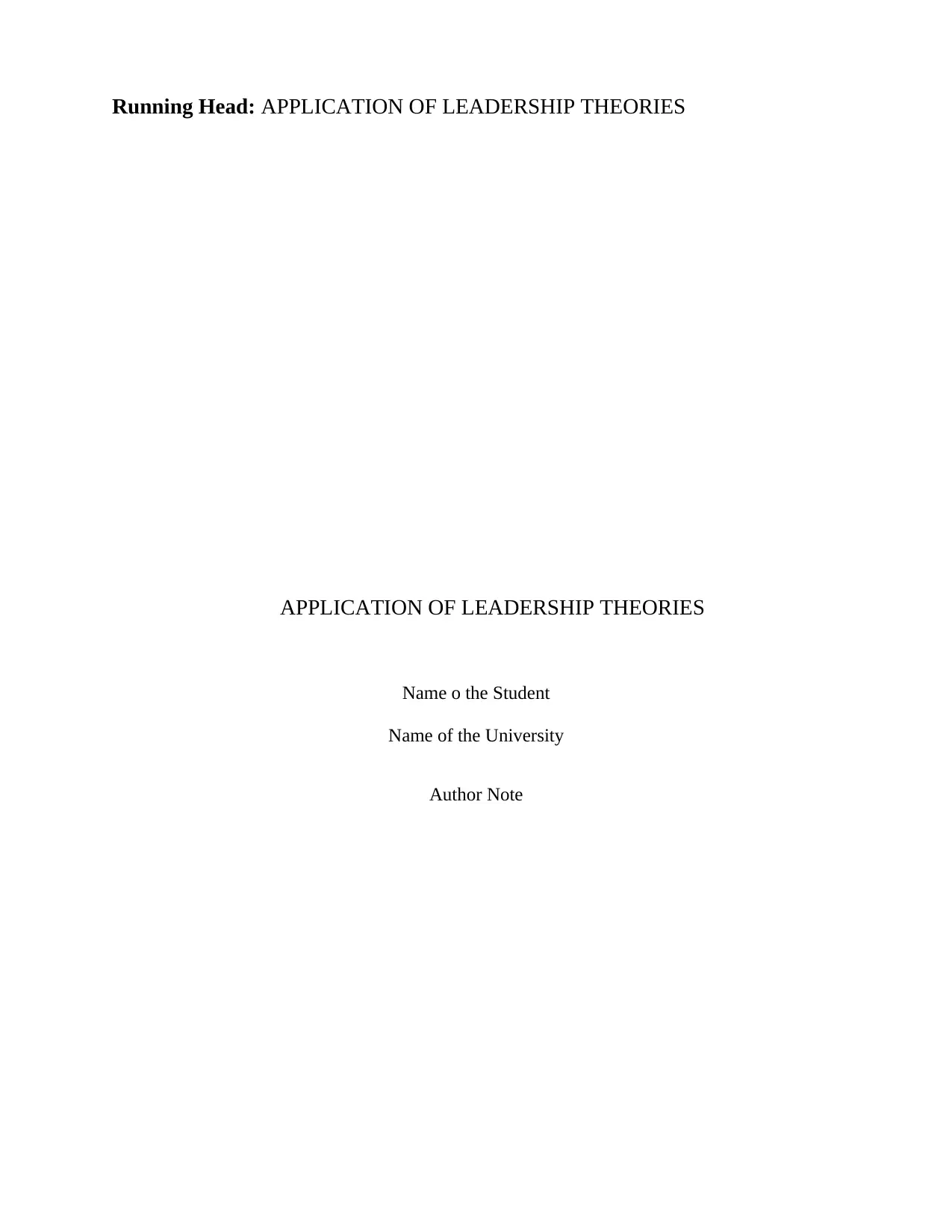
Running Head: APPLICATION OF LEADERSHIP THEORIES
APPLICATION OF LEADERSHIP THEORIES
Name o the Student
Name of the University
Author Note
APPLICATION OF LEADERSHIP THEORIES
Name o the Student
Name of the University
Author Note
Paraphrase This Document
Need a fresh take? Get an instant paraphrase of this document with our AI Paraphraser
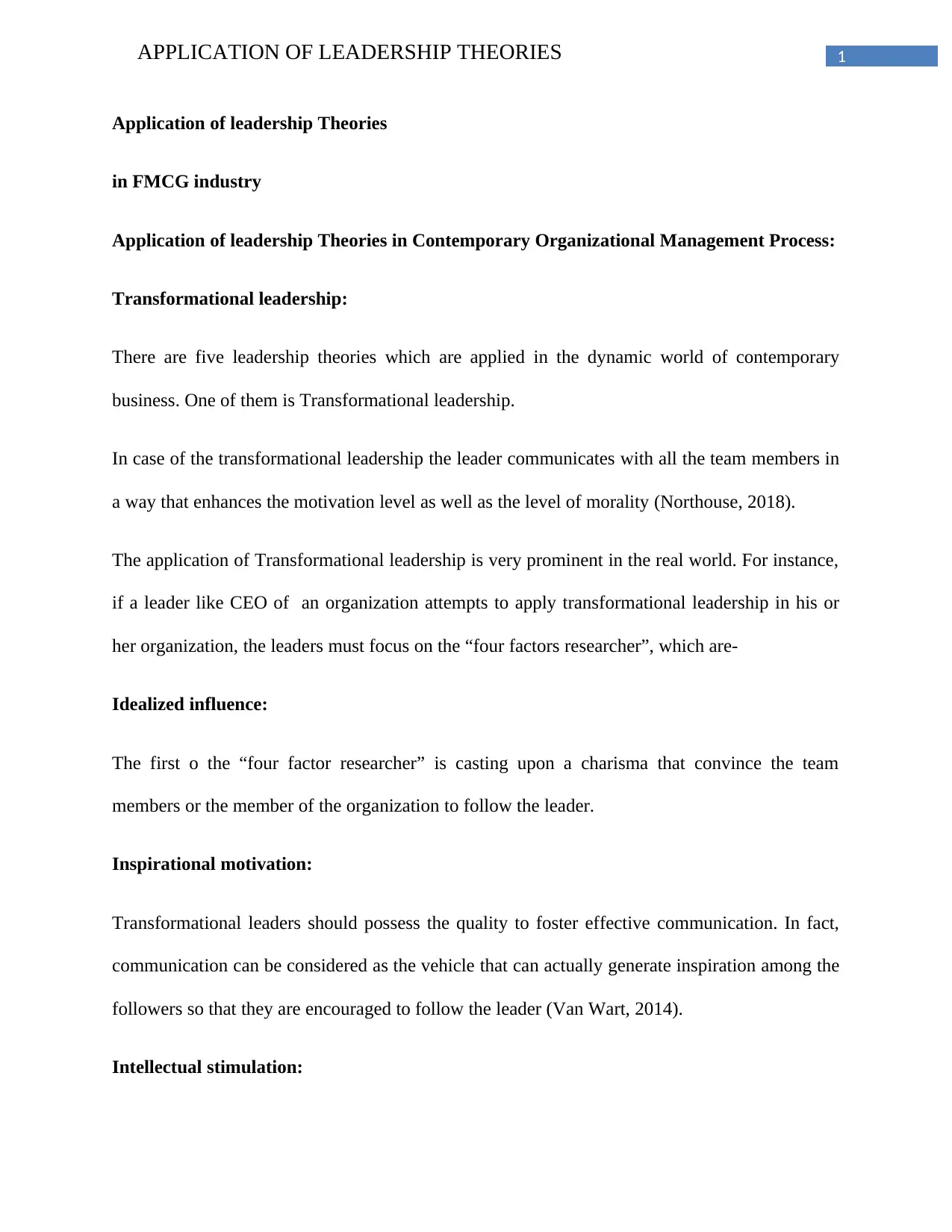
1APPLICATION OF LEADERSHIP THEORIES
Application of leadership Theories
in FMCG industry
Application of leadership Theories in Contemporary Organizational Management Process:
Transformational leadership:
There are five leadership theories which are applied in the dynamic world of contemporary
business. One of them is Transformational leadership.
In case of the transformational leadership the leader communicates with all the team members in
a way that enhances the motivation level as well as the level of morality (Northouse, 2018).
The application of Transformational leadership is very prominent in the real world. For instance,
if a leader like CEO of an organization attempts to apply transformational leadership in his or
her organization, the leaders must focus on the “four factors researcher”, which are-
Idealized influence:
The first o the “four factor researcher” is casting upon a charisma that convince the team
members or the member of the organization to follow the leader.
Inspirational motivation:
Transformational leaders should possess the quality to foster effective communication. In fact,
communication can be considered as the vehicle that can actually generate inspiration among the
followers so that they are encouraged to follow the leader (Van Wart, 2014).
Intellectual stimulation:
Application of leadership Theories
in FMCG industry
Application of leadership Theories in Contemporary Organizational Management Process:
Transformational leadership:
There are five leadership theories which are applied in the dynamic world of contemporary
business. One of them is Transformational leadership.
In case of the transformational leadership the leader communicates with all the team members in
a way that enhances the motivation level as well as the level of morality (Northouse, 2018).
The application of Transformational leadership is very prominent in the real world. For instance,
if a leader like CEO of an organization attempts to apply transformational leadership in his or
her organization, the leaders must focus on the “four factors researcher”, which are-
Idealized influence:
The first o the “four factor researcher” is casting upon a charisma that convince the team
members or the member of the organization to follow the leader.
Inspirational motivation:
Transformational leaders should possess the quality to foster effective communication. In fact,
communication can be considered as the vehicle that can actually generate inspiration among the
followers so that they are encouraged to follow the leader (Van Wart, 2014).
Intellectual stimulation:

2APPLICATION OF LEADERSHIP THEORIES
One of the unique capabilities that transformational leaders should possess for the purpose of
implementing transformational leadership is the stimuli to make other think deeply which in turn
will help the followers to perceive the vision of the leader.
Individualized concern:
For the purpose of applying transformational leadership, a leader needs to show care for every
individual who is following the leader.
Leader-Member Exchange Theory or LMX leadership:
The concept of this leadership theory has been developed depending on the difference in
characteristics and opinions along with compatibility of the in –group as well as out-group
members (Antonakis & Robert, 2013).
The application of LMX leadership in FMCG Industry
The application of LMX leadership is very prominent in the real world. A leader needs to show
individualized concern and should be able to motivate the out-group members to follow the his
or her views norms as well as rules, so that the difference between the in-group and out-group
members can be eliminated and productivity can be increased.
Adaptive Leadership:
The term “Adaptive Leadership” refers to the capability of the leader to mobilize people who
work in his or her team, so that the team members can take up difficult challenges.
The behaviors that should be exhibited for the purpose of applying the theory of adaptive
leadership in real world are:
One of the unique capabilities that transformational leaders should possess for the purpose of
implementing transformational leadership is the stimuli to make other think deeply which in turn
will help the followers to perceive the vision of the leader.
Individualized concern:
For the purpose of applying transformational leadership, a leader needs to show care for every
individual who is following the leader.
Leader-Member Exchange Theory or LMX leadership:
The concept of this leadership theory has been developed depending on the difference in
characteristics and opinions along with compatibility of the in –group as well as out-group
members (Antonakis & Robert, 2013).
The application of LMX leadership in FMCG Industry
The application of LMX leadership is very prominent in the real world. A leader needs to show
individualized concern and should be able to motivate the out-group members to follow the his
or her views norms as well as rules, so that the difference between the in-group and out-group
members can be eliminated and productivity can be increased.
Adaptive Leadership:
The term “Adaptive Leadership” refers to the capability of the leader to mobilize people who
work in his or her team, so that the team members can take up difficult challenges.
The behaviors that should be exhibited for the purpose of applying the theory of adaptive
leadership in real world are:
⊘ This is a preview!⊘
Do you want full access?
Subscribe today to unlock all pages.

Trusted by 1+ million students worldwide
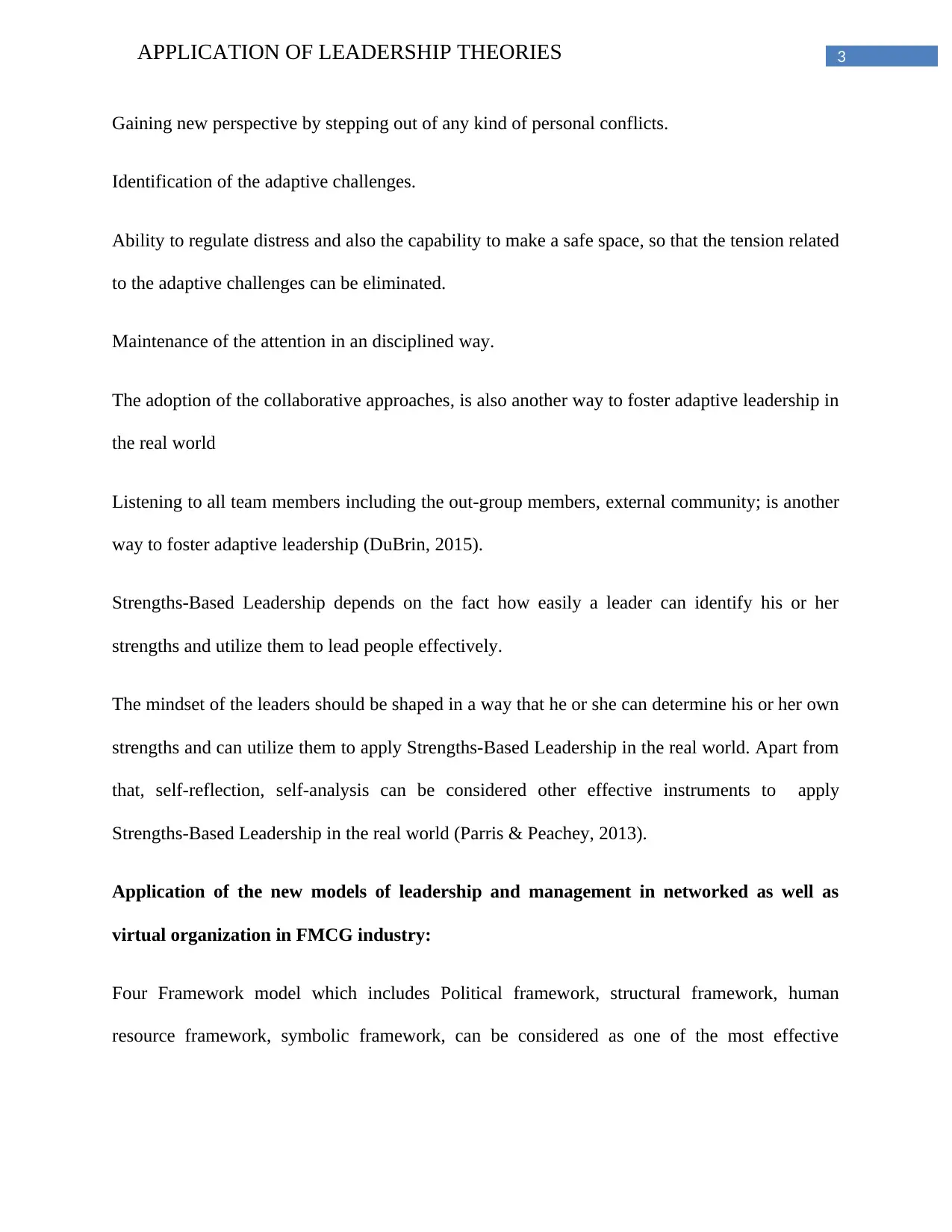
3APPLICATION OF LEADERSHIP THEORIES
Gaining new perspective by stepping out of any kind of personal conflicts.
Identification of the adaptive challenges.
Ability to regulate distress and also the capability to make a safe space, so that the tension related
to the adaptive challenges can be eliminated.
Maintenance of the attention in an disciplined way.
The adoption of the collaborative approaches, is also another way to foster adaptive leadership in
the real world
Listening to all team members including the out-group members, external community; is another
way to foster adaptive leadership (DuBrin, 2015).
Strengths-Based Leadership depends on the fact how easily a leader can identify his or her
strengths and utilize them to lead people effectively.
The mindset of the leaders should be shaped in a way that he or she can determine his or her own
strengths and can utilize them to apply Strengths-Based Leadership in the real world. Apart from
that, self-reflection, self-analysis can be considered other effective instruments to apply
Strengths-Based Leadership in the real world (Parris & Peachey, 2013).
Application of the new models of leadership and management in networked as well as
virtual organization in FMCG industry:
Four Framework model which includes Political framework, structural framework, human
resource framework, symbolic framework, can be considered as one of the most effective
Gaining new perspective by stepping out of any kind of personal conflicts.
Identification of the adaptive challenges.
Ability to regulate distress and also the capability to make a safe space, so that the tension related
to the adaptive challenges can be eliminated.
Maintenance of the attention in an disciplined way.
The adoption of the collaborative approaches, is also another way to foster adaptive leadership in
the real world
Listening to all team members including the out-group members, external community; is another
way to foster adaptive leadership (DuBrin, 2015).
Strengths-Based Leadership depends on the fact how easily a leader can identify his or her
strengths and utilize them to lead people effectively.
The mindset of the leaders should be shaped in a way that he or she can determine his or her own
strengths and can utilize them to apply Strengths-Based Leadership in the real world. Apart from
that, self-reflection, self-analysis can be considered other effective instruments to apply
Strengths-Based Leadership in the real world (Parris & Peachey, 2013).
Application of the new models of leadership and management in networked as well as
virtual organization in FMCG industry:
Four Framework model which includes Political framework, structural framework, human
resource framework, symbolic framework, can be considered as one of the most effective
Paraphrase This Document
Need a fresh take? Get an instant paraphrase of this document with our AI Paraphraser
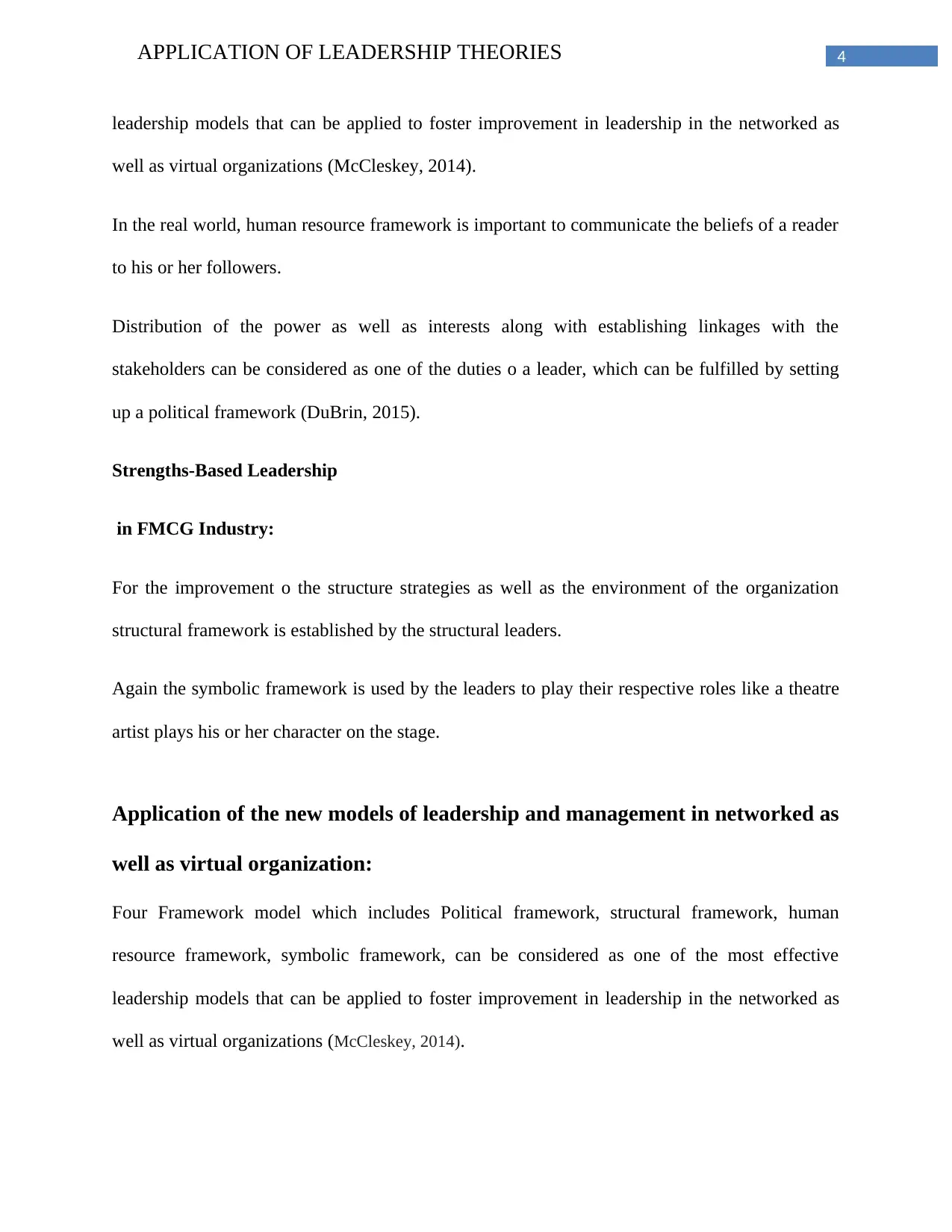
4APPLICATION OF LEADERSHIP THEORIES
leadership models that can be applied to foster improvement in leadership in the networked as
well as virtual organizations (McCleskey, 2014).
In the real world, human resource framework is important to communicate the beliefs of a reader
to his or her followers.
Distribution of the power as well as interests along with establishing linkages with the
stakeholders can be considered as one of the duties o a leader, which can be fulfilled by setting
up a political framework (DuBrin, 2015).
Strengths-Based Leadership
in FMCG Industry:
For the improvement o the structure strategies as well as the environment of the organization
structural framework is established by the structural leaders.
Again the symbolic framework is used by the leaders to play their respective roles like a theatre
artist plays his or her character on the stage.
Application of the new models of leadership and management in networked as
well as virtual organization:
Four Framework model which includes Political framework, structural framework, human
resource framework, symbolic framework, can be considered as one of the most effective
leadership models that can be applied to foster improvement in leadership in the networked as
well as virtual organizations (McCleskey, 2014).
leadership models that can be applied to foster improvement in leadership in the networked as
well as virtual organizations (McCleskey, 2014).
In the real world, human resource framework is important to communicate the beliefs of a reader
to his or her followers.
Distribution of the power as well as interests along with establishing linkages with the
stakeholders can be considered as one of the duties o a leader, which can be fulfilled by setting
up a political framework (DuBrin, 2015).
Strengths-Based Leadership
in FMCG Industry:
For the improvement o the structure strategies as well as the environment of the organization
structural framework is established by the structural leaders.
Again the symbolic framework is used by the leaders to play their respective roles like a theatre
artist plays his or her character on the stage.
Application of the new models of leadership and management in networked as
well as virtual organization:
Four Framework model which includes Political framework, structural framework, human
resource framework, symbolic framework, can be considered as one of the most effective
leadership models that can be applied to foster improvement in leadership in the networked as
well as virtual organizations (McCleskey, 2014).
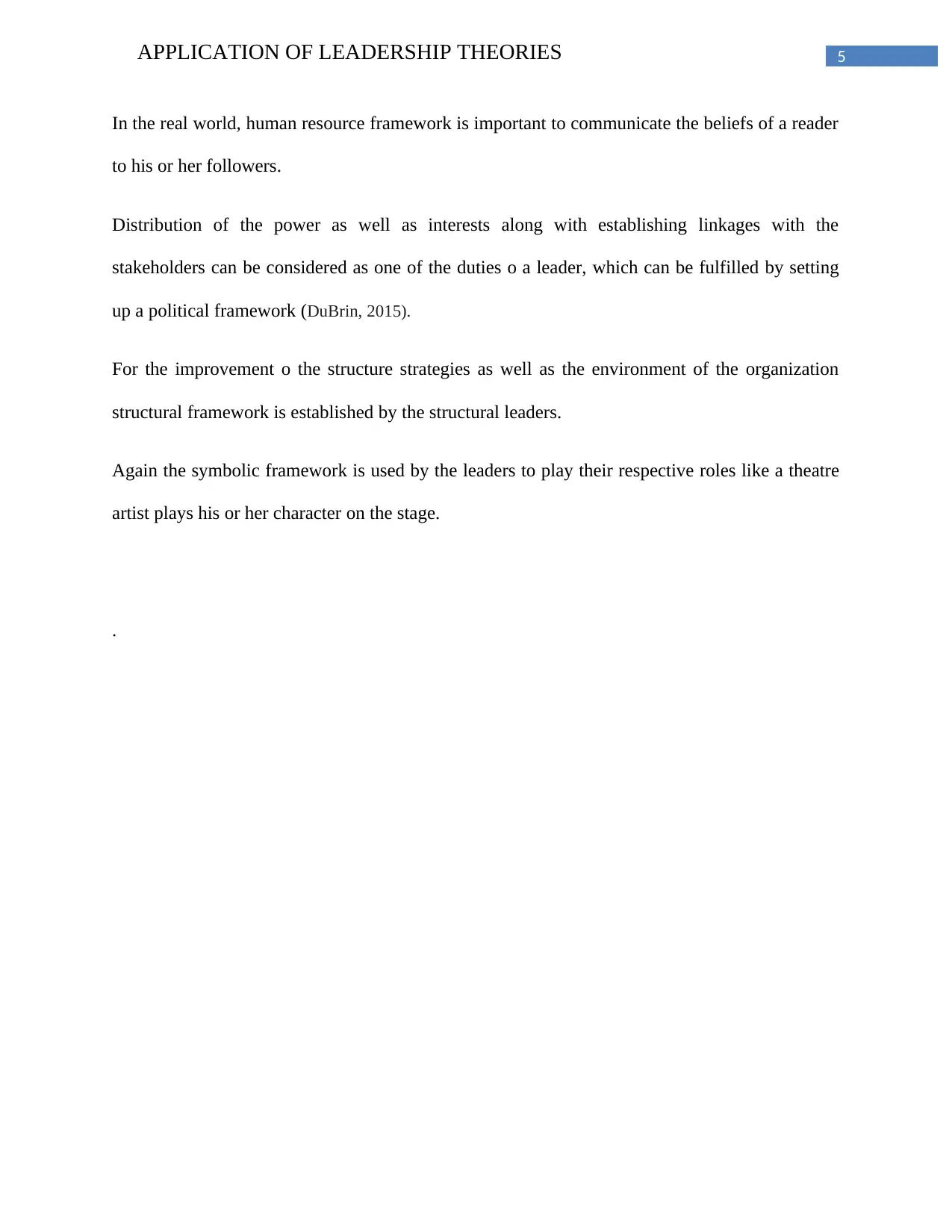
5APPLICATION OF LEADERSHIP THEORIES
In the real world, human resource framework is important to communicate the beliefs of a reader
to his or her followers.
Distribution of the power as well as interests along with establishing linkages with the
stakeholders can be considered as one of the duties o a leader, which can be fulfilled by setting
up a political framework (DuBrin, 2015).
For the improvement o the structure strategies as well as the environment of the organization
structural framework is established by the structural leaders.
Again the symbolic framework is used by the leaders to play their respective roles like a theatre
artist plays his or her character on the stage.
.
In the real world, human resource framework is important to communicate the beliefs of a reader
to his or her followers.
Distribution of the power as well as interests along with establishing linkages with the
stakeholders can be considered as one of the duties o a leader, which can be fulfilled by setting
up a political framework (DuBrin, 2015).
For the improvement o the structure strategies as well as the environment of the organization
structural framework is established by the structural leaders.
Again the symbolic framework is used by the leaders to play their respective roles like a theatre
artist plays his or her character on the stage.
.
⊘ This is a preview!⊘
Do you want full access?
Subscribe today to unlock all pages.

Trusted by 1+ million students worldwide
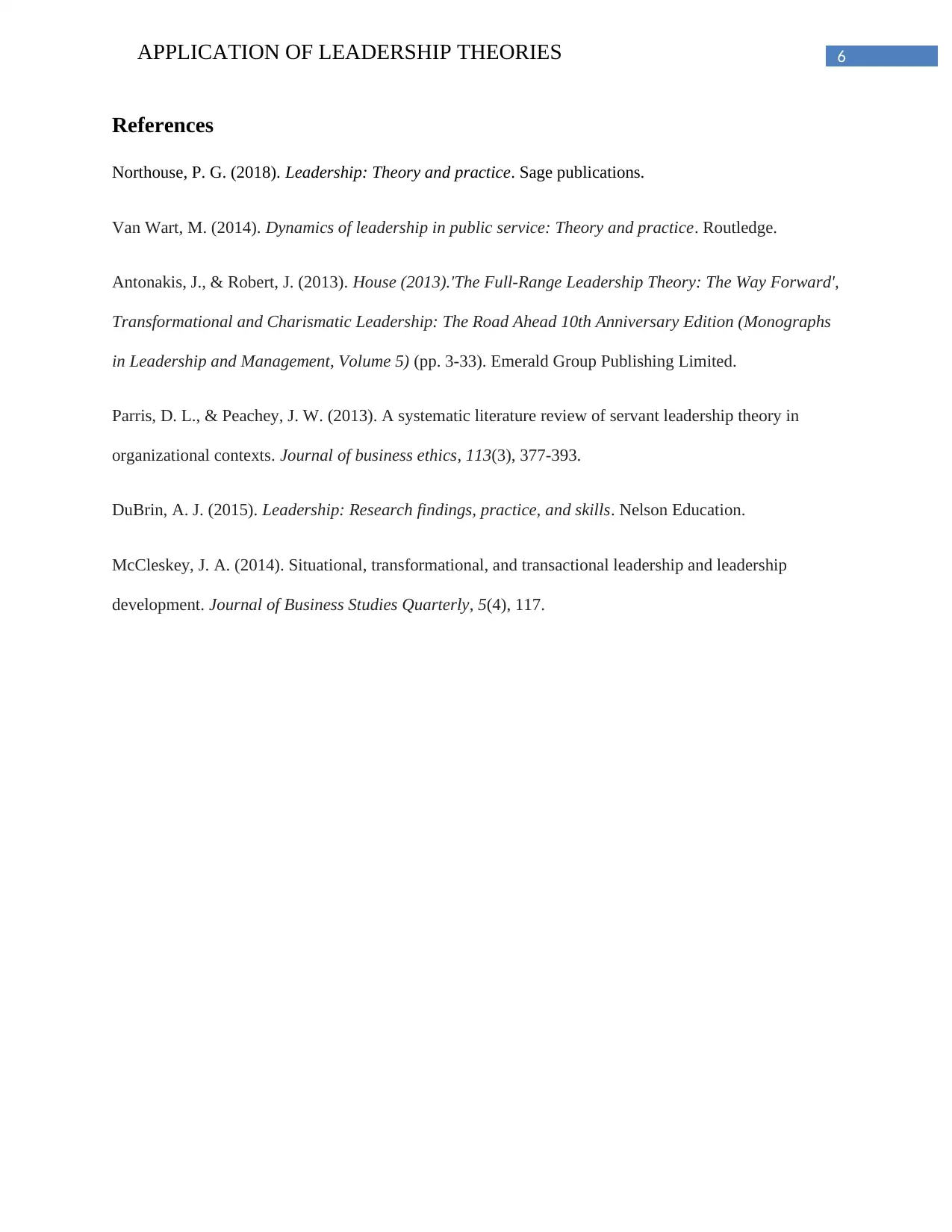
6APPLICATION OF LEADERSHIP THEORIES
References
Northouse, P. G. (2018). Leadership: Theory and practice. Sage publications.
Van Wart, M. (2014). Dynamics of leadership in public service: Theory and practice. Routledge.
Antonakis, J., & Robert, J. (2013). House (2013).'The Full-Range Leadership Theory: The Way Forward',
Transformational and Charismatic Leadership: The Road Ahead 10th Anniversary Edition (Monographs
in Leadership and Management, Volume 5) (pp. 3-33). Emerald Group Publishing Limited.
Parris, D. L., & Peachey, J. W. (2013). A systematic literature review of servant leadership theory in
organizational contexts. Journal of business ethics, 113(3), 377-393.
DuBrin, A. J. (2015). Leadership: Research findings, practice, and skills. Nelson Education.
McCleskey, J. A. (2014). Situational, transformational, and transactional leadership and leadership
development. Journal of Business Studies Quarterly, 5(4), 117.
References
Northouse, P. G. (2018). Leadership: Theory and practice. Sage publications.
Van Wart, M. (2014). Dynamics of leadership in public service: Theory and practice. Routledge.
Antonakis, J., & Robert, J. (2013). House (2013).'The Full-Range Leadership Theory: The Way Forward',
Transformational and Charismatic Leadership: The Road Ahead 10th Anniversary Edition (Monographs
in Leadership and Management, Volume 5) (pp. 3-33). Emerald Group Publishing Limited.
Parris, D. L., & Peachey, J. W. (2013). A systematic literature review of servant leadership theory in
organizational contexts. Journal of business ethics, 113(3), 377-393.
DuBrin, A. J. (2015). Leadership: Research findings, practice, and skills. Nelson Education.
McCleskey, J. A. (2014). Situational, transformational, and transactional leadership and leadership
development. Journal of Business Studies Quarterly, 5(4), 117.
1 out of 7
Related Documents
Your All-in-One AI-Powered Toolkit for Academic Success.
+13062052269
info@desklib.com
Available 24*7 on WhatsApp / Email
![[object Object]](/_next/static/media/star-bottom.7253800d.svg)
Unlock your academic potential
Copyright © 2020–2025 A2Z Services. All Rights Reserved. Developed and managed by ZUCOL.





